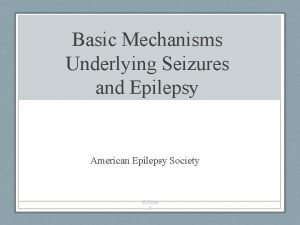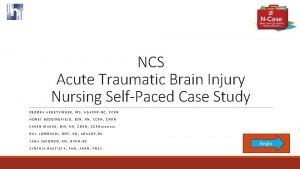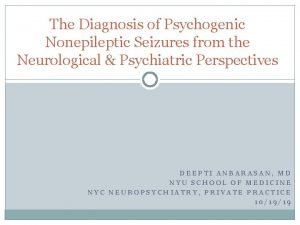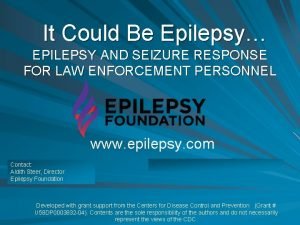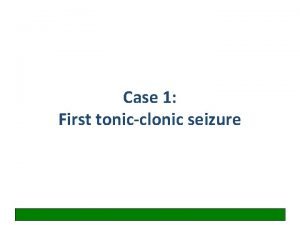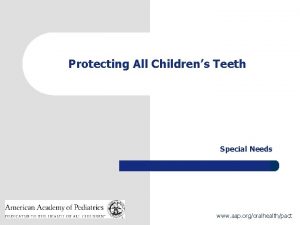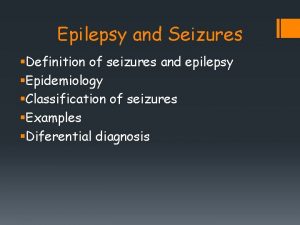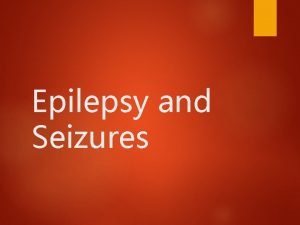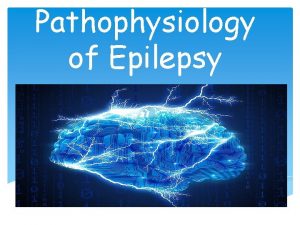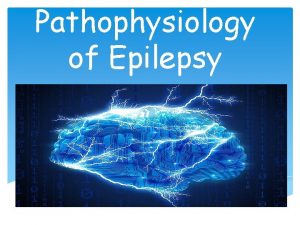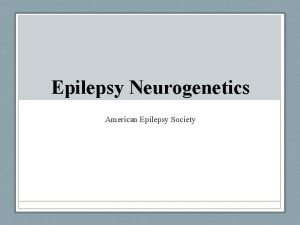The many faces of seizures in epilepsy in












- Slides: 12

The many faces of seizures in epilepsy in people with cavernomas International Cavernoma Alliance UK Forum London, 13 June 2015 Dr Tim Wehner National Hospital for Neurology & Neurosurgery University College London United Kingdom

Take home messages Ø Ø Ø Epileptic seizures are the most common first presentation of a cavernous angioma The cavernoma is often, but not always, the cause of the seizures The risk of seizures and the manifestation of seizures depend on the location of the cavernoma in the brain The first line treatment are seizure medications (Lamotrigine, Carbamazepine, Levetiracetam, and others) Epilepsy surgery should be considered in people with cavernoma who do not become seizure free on seizure medications

What are epileptic seizures? Ø Ø Ø An epileptic seizure is a sudden change of behaviour and/or subjective experience, caused by hypersynchronous discharges of neurons in the brain (“electrical storm“) Epileptic seizures may indicate an underlying medical or neurological disorder In principle, epileptic seizures can be provoked in any person‘s brain, e. g. through sleep deprivation, drugs, electrical stimulation, … 1 in 20 people have an epileptic seizure in their life Importantly, not all seizures are epileptic seizures.

What is Epilepsy? – Clinical definition Ø Ø A brain disorder that is characterized by occurence of unprovoked epileptic seizures About 1 in 131 people in the UK, i. e. ~ 500. 000 people, have epilepsy >50 Million people have epilepsy worldwide Most common disabling chronic neurological disorder

Classification of Seizures & Epilepsies Generalised - absence - atonic - myoclonic - tonic-clonic Focal / partial -without alteration of conciousness (“simple partial”) -with alteration of conciousness (“complex partial”) GENETIC (“idiopathic”) STRUCTURAL – METABOLIC (“symptomatic”) CRYPTOGENIC (“unknown”)

Symptomatogenic areas Left hemisphere, lateral aspect

Symptomatogenic areas Left hemisphere, mesial aspect

Symptomatogenic areas Left Insula

Relationship of Cavernoma and Epilepsy Definite CRE: This term refers to epilepsies in patients with at least one CCM and with evidence of a seizure-onset zone in the immediate vicinity of the CCM. Example: A patient with left hand tonic–clonic seizures and a right M 1 hand area CCM. Probable CRE: This is defined as epilepsy in a patient with at least one CCM and with evidence that the epilepsy is focal and arises from the same hemisphere as the CCM but not necessarily in its immediate vicinity. At the same time, there is no evidence of other causes for the epilepsy. Example: A patient with a left occipital lobe CCM and a history of a right versive seizure indicating a left hemisphere seizure onset. Cavernomas unrelated to epilepsy: This is defined as epilepsy in a patient with at least one CCM with evidence that the CCM and the epilepsy are not causally related. Example: A patient with bilateral myoclonic seizures after awakening, generalized 3– 4 Hz spike and wave complexes, a photoparoxysmal response on electroencephalography (EEG) (suggestive of juvenile myoclonic epilepsy [JME]), and a right temporal lobe CCM. Rosenow et al, Cavernoma related epilepsy, ILAE task force, Epilepsia 2013

Risk factors for seizures in people with cavernoma Established risk factors Ø Cavernomas in the grey matter of the brain Ø Cavernomas in the mesial temporal region of the brain Uncertain risk factors Ø Number of cavernomas Ø Size of cavernoma Ø Presence or absence of hemosiderin rim around the cavernoma Rosenow et al, Cavernoma related epilepsy, ILAE task force, Epilepsia 2013

Prognosis for epileptic seizures in people with cavernoma Ø Ø In people with an incidental cavernoma and no history of seizures, the risk of seizures is 4% over 5 years. Prophylactic treatment is therefore not necessary. In people with cavernoma related seizures, the risk of further seizures without treatment is 94% over 5 years. => Treatment is recommended after the first seizure. 50 -60% of people with cavernoma – related epilepsy become seizure free on medications. 60 -80% of people with cavernoma become seizure free after epilepsy surgery for cavernoma over 2 -5 years. Rosenow et al, Cavernoma related epilepsy, ILAE task force, Epilepsia 2013

Acknowledgements • • Colleagues in Neurology, Neurosurgery, Neurophysiology and Video telemetry unit at NHNN Patients in the videos who consented to show their seizures during lectures
 Basic mechanisms underlying seizures and epilepsy
Basic mechanisms underlying seizures and epilepsy It has 6 square surfaces and 12 edges
It has 6 square surfaces and 12 edges Icp monitoring
Icp monitoring Shaking vs seizure
Shaking vs seizure Simple partial seizures vs complex
Simple partial seizures vs complex Classification of anticonvulsant drug
Classification of anticonvulsant drug Nursing management of encephalitis
Nursing management of encephalitis Non epileptic seizures
Non epileptic seizures What to do when someone has a seizure
What to do when someone has a seizure What is a seizure
What is a seizure Psychomotor seizures
Psychomotor seizures Seizures
Seizures Pediatric seizures
Pediatric seizures
